To illustrate the plot, the game needs a few essential elements. The asteroid is portrayed by a special game board, where positions of robots are represented by game pieces of various colors. The cargo turns into playing cards. A player can take them and communicate. One dice (it is not feasible to use two dice because they would give too-big values) defines the distance of each player's move.
The main goal is simple: the player should collect a specific number of batteries to start the shuttle. In most cases, this number can be equal to ten. To get a battery, the player needs to defeat a monster or opponent's robot.
The game starts with an attempt to create a robot. Each player takes three cards from the spares deck, but it is more than likely that he does not get enough cards to construct the robot. There will be repetitive or junk cards, so the game usually starts with semi-assembled and very weak apparatus.
According to the plot, the robots are at the surface of a small asteroid and the goal of the game is not correlated with a specific finish point on the map, so the game board looks like a looped path. The circle shape is an ideal option for the board. Setting its dimensions, we can use the main advantage of a digital game—flexibility. The radius can depend on the number of players. The more the number of players that enter the game, the larger the size of the asteroids. Another option is introducing game modes such as small planet, big planet, and so on, which let the players use specific dimensions of the board. If the board is small, but there are many players, the gameplay includes more fights and it can become more chaotic, but funnier as well:
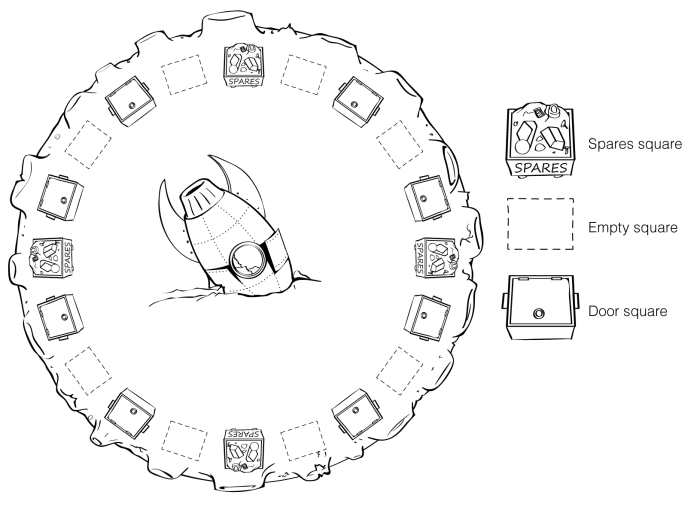
By default, the game board consists of three types of squares described as follows:
- Empty squares: These are cells where no action usually takes place. Recall the principle of peaks and valleys from Chapter 2, Ergonomics; this element is a valley, a zone of some relaxation for players.
- Door (or Container) squares: This is a peak element of gameplay, which consists of a zone with some actions. Here the player finds the door and his character must try to open it by using his power. If the door is successfully opened, the player get access to a container. He will find various things inside it, either useful (bonuses/tools) or dangerous (different types of monsters).
- Spares squares: There are only four of these on the board, and they are placed on opposite poles of the circle. The player can take some spare parts from special boxes and there are no obstacles, for example, doors and parts can be taken without any compensation.
Additionally, you can think about some other type of squares. For example, there can be power charger squares, where the powers of a robot become stronger (by one or two points). A tunnel can be introduced in the game, which would help to run away from opponents and overtake somebody on the board. So say the tunnel entrance/exit appears. I suggest using the dice to gain entry into the tunnel; if it shows a number greater than four or five, the player can travel through the core of the asteroid. Or a fare can be levied; pay by a tool or spares card to use the subway!
By default, empty squares and door squares should alternate with each other, but random placement of the doors can be intriguing too.
On the device, the game board is shown in two ways: partial and full. The first view is incorporated into the game UI; the player sees a section of the asteroid where his game piece is now situated, but only several squares are visible. This view can be scrolled to view other parts of the astronomical object and it would be great if an original form of the scrolling would be implemented; instead of horizontal and vertical panning of the image, you can use an algorithm, spinning it around the center point. The player will spin the asteroid with his finger (don't forget to simulate inertia), and that can look natural and breathtaking.
The full view shows up when a special button Show the map is pressed on the screen. In this case, the game displays the asteroid in full screen mode, showing all the game pieces; it can be useful for various tactical purposes.
The game is played by special cards, representing various details and situations. There are three dedicated card decks in the game, each of them with its own design on the back:
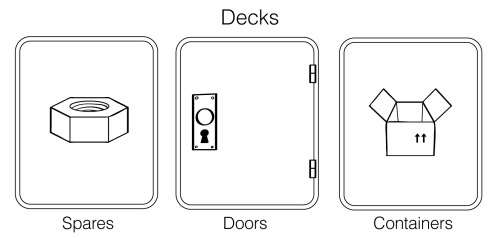
The backs of the dedicated decks in the game
- Spares: This deck consists of different parts of robots: heads, bodies, and legs. There are also some "empty" cards, called Junk. They play roles of little pitfalls because they have zero value and cannot be used for the creation of a robot.
- Doors: A lot of doors can be found in this deck. These cards protect the content of the containers. Some of them are unlocked, while others need some power or abilities to be opened.
- Containers: These cards illustrate the stuff that can be found in the container, when a corresponding door is successfully unlocked. They include a number of useful tools that which increase some powers of the robot, for example, blaster, and plasma cutter. There can be some cards, known as Spares, that let the player take a new card from the spares deck right at that moment without waiting for a spare square. Some monsters can inhabit the container as well; various dangerous creatures, such as crazy robots, angry magnets, wild waterfalls, and old wiring can attack the player's robot.
When the player must take a card from one of the decks, a pop-up window appears, showing some cards turned back; the player taps them and gets a card. Of course, this is unessential and the game can automatically display a card, not asking the player to take part in the dialog, but I'm sure that tapping the deck makes the process more attractive and tactile.
If a card needs to be dropped from the inventory to the deck, the game should focus on the inventory window, placing it at the center of the screen. The player chooses an unnecessary card and taps it, so it travels to the deck. There also can be a confirmation alert, asking whether the player is sure he wants to drop the card that was specified before. The position of the card that has returned to the deck should be random; it can become predictable if the card returns to the very end of the line. So try to rearrange the array of cards each time one item returns to it.
The robots are constructed from spare cards that the player takes from the dedicated deck. There are only three classes of these spares in the game:
- Heads
- Bodies
- Legs
Each of them has their own properties. The first two of them utilize a special number, which characterizes their power and can be used in a battle or to open a specific door. There is a gradation from 1 to 6; the greater the number, the more powerful the spare is. In general, a sum of body and head powers are used; for instance, the player has a robot with a very strong body marked 6 and a middling head with the number 2. If the robot does not hold any additional tools, its total power will be 6 + 2 = 8. Sometimes, only a partial amount of power is required. Various forms of smart doors or monsters appear only according to the power level of a robot's head, which is considered the level of the robot's intelligence. Contrarily, sometimes only brute force is needed, and the head is not used. The following figure shows different forms of cards we use for our robot:
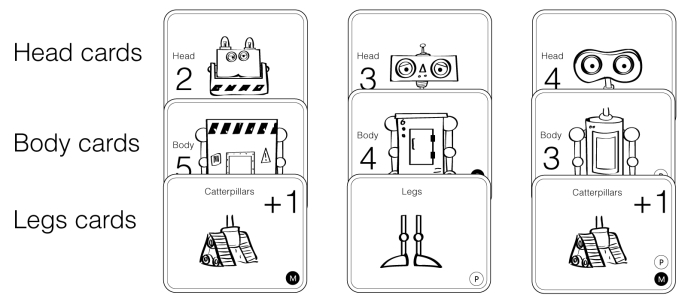
The leg has no power in the fight and no intelligence level either, but determines the way the robot moves. The simple ones, known simply as Legs, are not very fast, and the game piece moves by the number of squares that the dice has shown. The Caterpillars card gives more freedom of space; the player gets an extra square to move though it is not obligatory to make such a +1 move, and a more profitable destination can be chosen. The most attractive and of course, the rarest option is the jet, a little cylinder with a nozzle, allowing the robot to soar above the ground a little bit. The extra square it gives is equal to two and this gives a player full freedom of choice on the board.
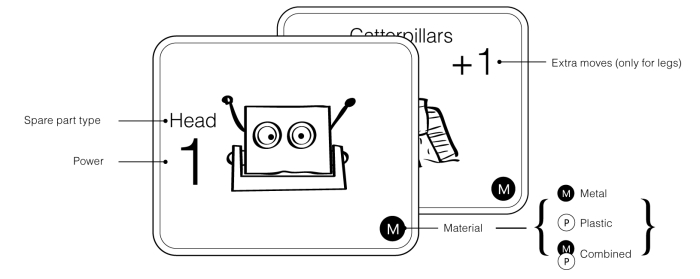
All the spares—including the legs—are subdivided into types, expressing the materials they are made of. Every card has special letter marks to display the material. There are metallic spares (M), plastic ones (P) and combined ones (MP). Generally, there is no difference between the materials; a metallic spare part is as good as a plastic one is. But sometimes it can be important. Monsters of an electric nature attack only metallic parts, their high-temperature counterparts like to melt plastic, and so forth.
The player should collect all the three classes (independent to their power value and material) in order for their robot to function normally. If there are fewer classes at the player's table, some restrictions are applied to the character. Let's see some of these:
- Only a head: In this, the robot cannot use his full potential; he moves very slowly, only one square per move, and the dice is not used. His goal is to reach a spares square, hoping that he gets some legs or a body. Such a robot can open doors, if its head has enough power and even can defeat a weak enemy. It is important to remember that a robot without a body cannot use any tools because it has no hands to hold them in.
- Only a body: In this, the robot is still defective and cannot move fast, but he already has the ability to hold some tools in his hands.
- Head plus body: This is a more pleasant combination. The robot is more powerful and can use tools, but he is still very slow. It gives the same one square per move option and there is no advantage of a dice.
- Only legs: This is the most pathetic situation. The robot can move by the help of dice, but he has no opportunity to fight because the legs have no power. It is an easy target for other players and monsters and should try to quickly find a spares square.
- Digital phantom: In this, there is no spare part. The robot exists like a digital ghost, supposedly saved in the cloud storage system, hosted on the main computer of the spaceship, which survived the crash. The phantom can move slowly, he cannot open doors and cannot be attacked by others; he should find a spares square and begin to materialize again.
Few cards have a zero sign, called nonentity spares, which means that the part is almost broken, but formally, they still work. Although as good as garbage, they can be useful in some situations, for example, if the robot has no normal body, it can use a nonentity part. This gives it zero power, but lets it hold some tools:
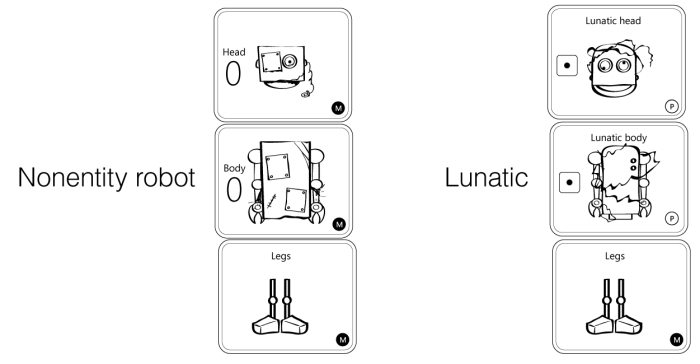
The most interesting things are the Lunatic spares; they have no number, but only a symbol of a dice. Legend says that such spare parts were affected by the mysterious powers of the asteroids, so they lost their memory and now they do not remember their true talents and power. Hence, the dice should be used to determine the value of these spares. This should be done each time the robot tries to open a door or beat somebody. The lunatic spares depend on good luck; they can be either very strong or very weak.
Each container at the asteroid has a door, which protects the cargo inside. Few of them have no locks and so can be opened without any efforts, but most of them are reliably locked; therefore, the player should use the powers of his/her robot to get inside:

A chart showing various types of doors
A door card has a special number, which represents the resistance force of the door; if the robot is strong enough and the sum of his powers are greater than that number, he enters inside the container; otherwise, he gets nothing. It is important to mention that there are some specific doors, which can be unlocked only by intelligence, or in other words, by using the power of the robot's head. They are known as Smart doors. A very rare type of a door is the Lunatic door. The player has to throw a dice to get a chance to enter, and the conditions are written on the card.
In the containers, there are a lot of tools or weapons a robot can use to fight or to open a door. Some of them are for permanent use and have small power (values that lie between one and three), but other ones are valid for one occasion only, being much more powerful (a good illustration is the plasma grenade, which has a power value equal to five). To use a tool, the robot should hold it in his hand; otherwise, the card will not work, being considered as a part of inventory:

Unlike the spares cards, which can be rearranged only before the player's move, the tool cards can be replaced in the robot's hands right before the fight. It's worth noting that non-permanent tools should be returned to the deck directly after being used, so if the player has applied such a tool to open a door, he cannot use it against the monster inside. First of all, he must return the tool; then, before the battle, he can take another tool from his inventory (if he has additional ones).
The game flexibility is supported by diversification of special conditions some tools work with. Most of them are of course universal, but some of the tools work only with metallic bodies or require the robot to have high intelligence. Huge hammers can be used only with strong bodies and so on.
Permanent tools cannot be lost by a player in normal conditions, but they can be taken by some monsters. Bonuses are rare, but can be invaluably useful. They can reward the player with extra spares, a free battery (an extremely rare card), an additional move, and so on.
First of all, the term "monster" in our case is rather symbolic than literal because many of them are not traditional creatures from human nightmares, but situations from a robot's bad dreams. Falling water, puddles of oil, gigantic magnets, transformers, mills, bare wires, computer bugs, and other industrial scary things can be found inside the containers. In a broad sense, they can be called traps:

The monster card consists of two parts: the first one is a monster description, including the value of its power and some conditions of its functionality, while the second part describes the aftermath, which will take place in a case the player loses.
A monster's guile should be to target specific characteristics of a robot; this creates some variety in attacks. The diverseness is very important since players can use various tactics; most importantly, they can take a risk sacrificing some parts of their robots, nonetheless trying to overcome an opponent. Such mechanics force more emotions to be involved in the gameplay. Moreover, monsters with different characteristics seem more dangerous and unpredictable; you never know what you will lose.
If a game has a monster with a single type of attack, it will soon become very simple to decide how to defeat it; the sense of risk will be very insignificant and the player will develop some sort of a comfort zone they will rarely leave. But a great game experience requires players to try many ways to achieve the result; good gameplay is a creative process! Therefore, game elements need to push them in that direction. Several classes of the monsters can be created:
- Universal: They attack all types of robots.
- Electricity/Magnets: Mostly attack metallic details, so almost harmless to plastic robots.
- High temperature: It melts plastic spares and is very dangerous for highly intelligent robots, which are made of plastic.
- Cracks and puddles: These pitfalls are tricky for a robot's legs.
- Water: It is dangerous for metallic robots (they can lose a move) and it shuts down jet legs.
- Sphinxes: These are usually old robots, which a long time ago were security guards. Now they are bored and like to ask various conundrums to create some entertainment for themselves. Thus, only robots with high intelligence can defeat them.
- Bouncers: Old robot loaders, they can understand only brutal force, so the head of the player's robot cannot be used in the fight.
- Wires: These are hodgepodges of various wires and cables, which knots the robot, so he has no opportunity to use his hands and tools.
- Bugs: These are the most abstract and unexpected pitfalls. Errors in electronic systems push the robots to make pretty strange things. For example, the head begins to fight with the body. Or the player has to give his entire inventory to another player.
A special preference of the monster means that some parts of the robot can be blocked. For example, the magnet paralyzes all the metallic parts, and they are not used in the fight (for combined spares, their power value becomes lesser in a half); the robot can only depend on tools he has in his hands. But remember that such monsters should not feature a big value of power, so the player would have a chance to overcome them. Now you see that such diversity pushes the players to use all features, not fixating on only one arsenal of gaming tools. Basically, the idea is to train a player with gentle slaps: Try this, now try that, use this item, and so on. Players should know that there are many ways to solve a problem. Of course, the training works fine if there are noticeable rewards in a form of successes in the game or special achievements.
The aftermath should not be very ruthless; an ordinary universal robot can only make the player lose his next move. Some monsters can take some spares, for example, various puddles take away robot's legs. Sphinxes like trophies in a form of robot heads. Only weak monsters or the robot itself should withdraw the battery.
Besides, the monsters in containers can be a real bad thing: a pitfall card, which is unconditional and cannot be defeated. One of the good illustrations is the card You lose your robot!; by getting this, a player loses all current spares and his robot becomes a digital phantom. There is another terrible card that says You lose one battery!.
Remember that risks in games should be well balanced. Motivation mechanics for players (for some AI systems) is based on playing with two general ambitions: to be secure (to be alive) and to get some rewards (satisfaction). In most cases, they contradict each other because, to be secure, it is better to hide somewhere and not move. But to get some prizes, you need to face some danger. That is a basic existential principle, which is why such a choice during playing generates some strong emotions.
Any risk must be worth the reward a player gets, and in some cases, it should outweigh the possible aftermath of failure. This forces players to take risks and make more experiments. On the other hand, if the aftermath is too weak, the players may become too arrogant, and their emotional state will be very indifferent to events. You have to remember a crucial thing: a player is playing a game, while you (as the author of the game) are playing with his emotions, motivations, and actions. Without emotions, choices, and experience, games are flat software with some beautiful pictures.
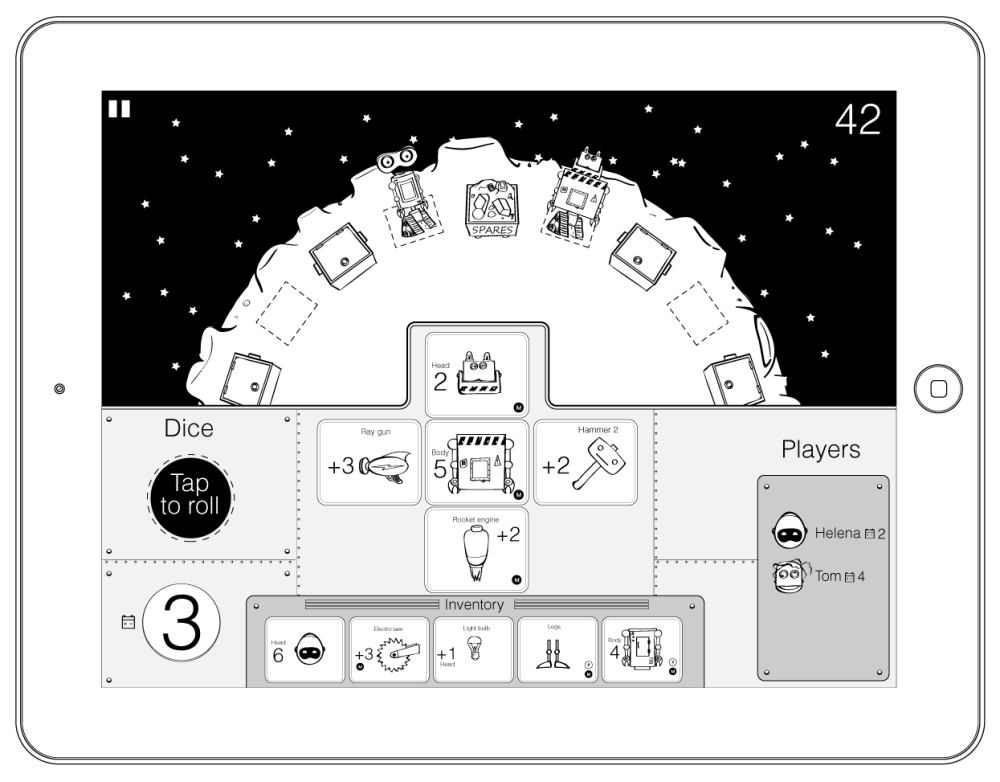
The screen layout for the main game screen
The game table (or player's UI) consists of several parts. Primarily, there is a section showing some view of the game board, which was mentioned before. Below it, there is the robot section with placeholders for corresponding spares cards. Near the placeholder for a body, there are robot's arms, where tool cards can be placed. At the right-hand side of the screen, is the inventory section; it can hold up to five cards of any type. So overall, a player can have a maximum of ten cards in his hands (three body parts, two arms, and five inventory and cards); all surpluses should be dropped back to the card decks.
By default, all the cards go directly to the inventory; the player should choose the necessary cards for his robot by himself. The UI mechanics are simple: the player taps a placeholder in the robot section, for instance the head, and then selects the cards he needs from the inventory.
The opponents are shown as icons at the top part of the screen. By tapping on them, the player can call a pop-up window, showing the current state of the opponent's robot. All the cards are visible except for the inventory.
One of your goals as a game creator is to push players to drop their cards from the inventory for a greater variety of game tactics. This can be done roughly via various pitfalls or by introducing strong opponents. But it is more interesting to implement some more creative solutions which can expand the boundaries of gameplay. There should be such conditions in the game that a player would drop his cards voluntarily, exchanging them for some extra features. First of all, I'm talking about spares; they should not be deadwood. If the player successfully collects in the inventory all the basic spares of a robot—in other words if he has the head, the body, and the legs—the robo-golem can be constructed and the player becomes his master. This is an artificial creature—more artificial than ordinary robots are—that has no mentality and will of its own; he cannot operate by himself, make any decisions, move in any direction, and so on. In most cases, he simply dreams and maybe sees some electric sheep. A robo golem can be placed on any square of the game board; he will stay there and wait for the moment somebody reaches it. Here are some scenarios that could occur in case somebody comes in contact with him, depending on the type of game board square he is on:
- Empty square/Spares square: The fight starts, and the robo-golem operates like a normal robot, so he uses all the powers written on his spares. He can defeat the opponent and take his battery, bringing it to his master! Otherwise, the opponent gets the robo-golem's battery. If the player contacts his own robotic creature, he can remove the robo-golem at any other position on the game board.
- Door square: In this case, the robo-golem does not fight with the opponent, but he helps any monster inside the containers; a robo-golem's power is summarized by the monster's strength. Together they can beat very powerful enemies; thus, in ideal conditions, it can act like a Joker. In case you lose, the opponent gets two batteries: the first one from the robo-golem and the second one from the monster. If the master reaches the container square with his own robo-golem, they can open the door and fight any monster inside together. In this case, player's power is united with the robo-golem, and as a team they can be invincible.
A robo-golem exists till a fight; regardless of whether he has succeeded in the battle or not, he must be wrecked, and his cards go to spares deck and can be reused. Robo golems are interesting elements of player's strategy because they can change the balance in the game, especially when several of them are created. They can make the gameplay pretty unpredictable and alive because situations can be a little bit abnormal as robo-golem does not depend on the game scenario and players. Such conditions are known as the emergent gameplay; this term describes the situations when the standard gameplay intentionally (developers hypothecate some sort of freedom in particular areas) or accidentally (because of a glitch or other type of undocumented situation) offers unexpected extra mechanics. The main advantage is that players discover such situations accidentally and this convinces them that a game is a pretty complex system with a lot of unexplored details. Hence, it is worth to play again and again testing the feature found already and explore some new ones. The most spectacular examples of the emergent gameplay are based on various glitches or some form of developer oversight. A canonical instance is a rocket jumping when a player fires through the ground (or other type of surface) while jumping to increase the distance of a jump, popularized by Quake from id Software. This feature was discovered by players and became very popular. The audience also tries to utilize such funny situations as opponents stuck somewhere in 3D surroundings or some gaps in the game levels to reach some locations faster. But more interesting are the intentional causes of the emergent gameplay when developers give some additional functionality or properties to some items so they can be used in other ways; for instance, several crates can be turned by a player into a ladder, helping to climb a roof. Since a good game is a field for experiments, there should be a chance for players to invent some new methods of achieving goals. The game should not have an obvious structure of logic; it must look much deeper, like a system with some hidden factors and properties.
A very good metaphor is a long corridor; it looks much more intriguing if it has several doors rather than empty walls. Even if the doors are fictional or locked, they create an illusion of a bigger world. By the way, this principle is very popular in level design. The location should look like a part of a larger universe, so only the correct gap could be found to escape it to a place, which is seen on the horizon.
Another funny idea is of using useful spares from the player's inventory. The robots, walking around without a proper goal, wanting only to have some "braains"; let's call them robo-zombies. In contrast to a robo-golem, he can be constructed only of two parts: the body and the legs. The head is not required. It gives the robo-zombie less power because the sum of two cards is not large, but that can be offset by the ability of autonomous moving around the game board. Being placed at any square, a robo-zombie begins to walk slowly in the direction chosen at random, making only one step at a game phase. He roams till he meets one of the following characters:
- Opponent: The robo-zombie tries to fight, failing to realize that his chances are not resplendent. In most common cases he loses, but the opponent gets nothing because there are no batteries inside these poor creatures, as with robo-golems. If they meet at the door square, the robo-zombie helps the monster with his power like a robo-golem does.
- Opponent's robo-golem/Opponent's robo-zombie: The robo-zombie fights with him. If he wins, the opponent's creature is destroyed, but the player's robo-walker continues his journey.
- Player: The robo-zombie assists with opening doors and fights the monsters from containers. If they reach each other at an empty square, the robo-zombie simply continues his promenade.
- Player's creatures: They work as a team till one of them leaves the corresponding game square. Robo-zombies can also change their direction.
Just like his step-brother golem the robo-zombie should be wrecked in parts and returned to the spares deck after a battle. The only exception is if there is a fight between the creatures; the one who wins, continues his life cycle.
I like the robo-zombie very much because it is the example of board game mechanics, which suits electronic realizations more than analog ones. Because it is not comfortable and sure to move a robo-zombie by hand in each move, remembering their directions, and so on. But the application can make such operations easily and visual.
The game uses initially a small wizard to create a robo creature. First of all, when the inventory gets enough parts to create a robo-golem or a robo-zombie, special icons should start blinking. If the player taps them, the inventory window centers at the screen. All the parts that are not related to creature generation become inactive (dark or semitransparent); the player has to choose all the parts he wants to spend on, and then he taps the Create button. After that, the game shows the fullscreen image of a game map, so the player can put his creature at the board. Don't forget about some allusions to Dr. Frankenstein; the sound of lightning, electric noises, and a sinister laugh are very appropriate.
